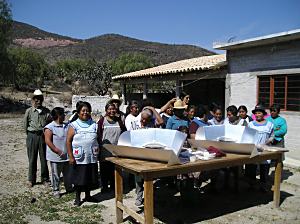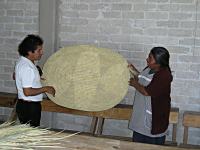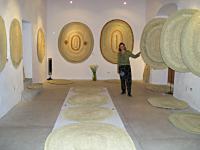
Mexican Straw Weavers in Mixteca Region of Oaxaca Learn to Solar Cook
“Pulvo de Agua’, an association of Mixteca artisans began in 1999 initiated by Jose Luis Garcia, a Mixteca Indian himself and a well-known muralist. I met all eight members of the association living in San Miguel Tequixtepec and 35 more in Suctrixlahuaca, located 30 minutes away. All are palm straw weavers, the great majority women. Some members are carpenters and potters, but I did not get to meet them. The artisans I met used to weave straw hats, made from palm and plastic fiber which paid very, very little — about .25 cents per hat !
Jose Luis encouraged them to try new designs. He helped them work out how to make straw mats that could be used for interior decoration and sold to the more affluent living in Oaxaca city. He organized an exhibit for them inside the historic museum ‘Casa de la Cuidad’ which opened the day of my arrival.

It was quite by accident how Jose Luis discovered solar cooking. Lorena, our HotPot Initiative coordinator in Oaxaca gave HotPot demonstration inside a café-bookstore where Jose Luis was completing a mural. She invited him to come taste some of the food. He was impressed and quickly saw the benefits of this technology. He arranged for Lorena to give a demonstration to members of the artisan association and I was fortunate enough to be there to join her.
The sun shines abundantly in the state of Oaxaca, Mexico’s most densely populated area, where the largest number of indigenous people live. There is a continuing drought due to the uncontrolled deforestation that has taken place during the last 50 years. A prior government sold large parts of the forest off which caused most of the problem, but the fact that the rural and peri-urban populations prefer to cook beans and tortillas with firewood increases it.  Bottled gas (LPG)is available and many use it too, but there are constant price increases. Firewood used to be free, provided you would cut it down and carry it home, but in most towns around Oaxaca city, it’s no longer free and the price is increases every few months. Sunshine is the fuel used to power solar ovens — it is FREE !
Bottled gas (LPG)is available and many use it too, but there are constant price increases. Firewood used to be free, provided you would cut it down and carry it home, but in most towns around Oaxaca city, it’s no longer free and the price is increases every few months. Sunshine is the fuel used to power solar ovens — it is FREE !
Lorena and I set up two HotPots in Tequixtepec and two in Suctrixlahuaca and showed the artisans how they work. One contained chicken stew, the other rice. Once the food was in the pots and the reflectors were oriented to catch the sun’s rays, the artisans could go weave because solar cooked food does not need to be attended to, it will not burn. The HotPot works a lot like a slow cooker and can be used to bake, stew and braze, but it cannot be used to fry or to make tortillas. It’s not necessary to add water or oil when cooking meats and vegetables or hard-baking eggs; it can be used to warm tortillas.
 Jose Luis joined us when the food was done. He encouraged the artisans to consider buying a HotPot and to stop cutting down trees; explaining that no longer finding palm fiber nearby is due to the lack of rain. The artisans were swayed by his word, more than ours, being the founder of their association.
Jose Luis joined us when the food was done. He encouraged the artisans to consider buying a HotPot and to stop cutting down trees; explaining that no longer finding palm fiber nearby is due to the lack of rain. The artisans were swayed by his word, more than ours, being the founder of their association.
When we left he said he would return next week with payment from the sales of their palm straw rugs that had all sold at the exhibit; then he added that each artisans should invest in buying a HotPot, that he’d add a percentage from the association as a subsidy.
We returned a week later with a HotPot for every artisan, each paid $20! Lorena followed up with a training workshop.



